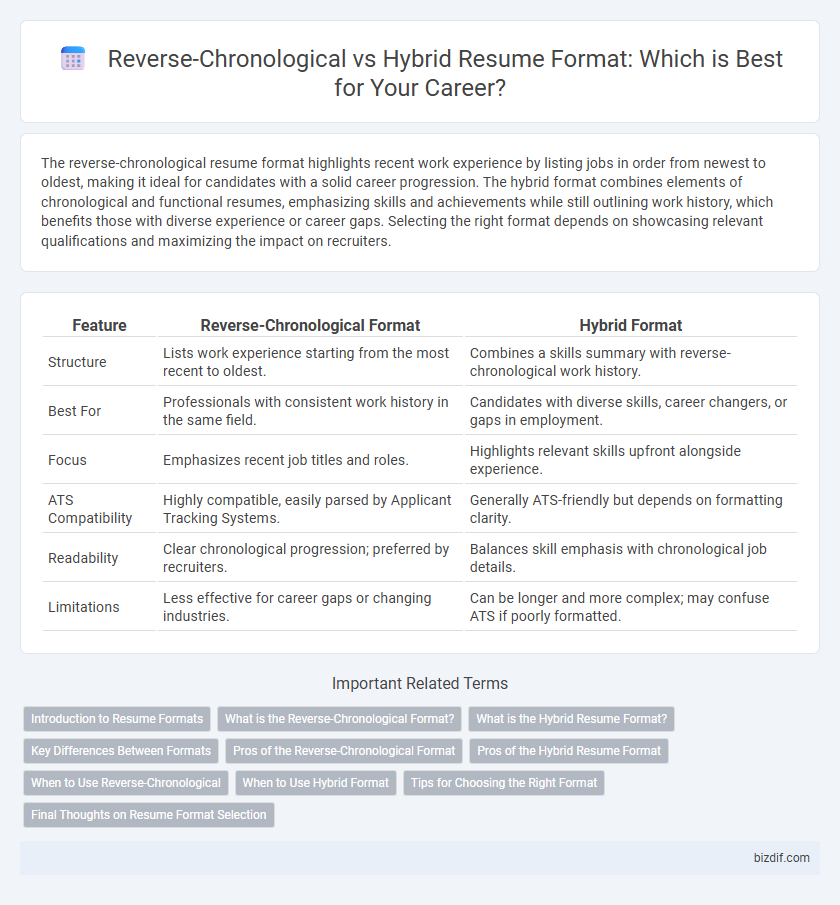The reverse-chronological resume format highlights recent work experience by listing jobs in order from newest to oldest, making it ideal for candidates with a solid career progression. The hybrid format combines elements of chronological and functional resumes, emphasizing skills and achievements while still outlining work history, which benefits those with diverse experience or career gaps. Selecting the right format depends on showcasing relevant qualifications and maximizing the impact on recruiters.
Table of Comparison
| Feature | Reverse-Chronological Format | Hybrid Format |
|---|---|---|
| Structure | Lists work experience starting from the most recent to oldest. | Combines a skills summary with reverse-chronological work history. |
| Best For | Professionals with consistent work history in the same field. | Candidates with diverse skills, career changers, or gaps in employment. |
| Focus | Emphasizes recent job titles and roles. | Highlights relevant skills upfront alongside experience. |
| ATS Compatibility | Highly compatible, easily parsed by Applicant Tracking Systems. | Generally ATS-friendly but depends on formatting clarity. |
| Readability | Clear chronological progression; preferred by recruiters. | Balances skill emphasis with chronological job details. |
| Limitations | Less effective for career gaps or changing industries. | Can be longer and more complex; may confuse ATS if poorly formatted. |
Introduction to Resume Formats
Reverse-chronological resume format highlights work experience by listing jobs in order from most recent to oldest, emphasizing career progression and stability. Hybrid resume format combines chronological work history with a skill-based section, allowing candidates to showcase relevant abilities alongside their employment timeline. Both formats serve distinct purposes: reverse-chronological suits traditional industries, while hybrid benefits those with diverse skill sets or career changes.
What is the Reverse-Chronological Format?
The reverse-chronological format organizes work experience starting with the most recent job, highlighting career progression and stability. This format is widely preferred by employers due to its clear and straightforward presentation of employment history. It effectively showcases relevant skills and accomplishments in the context of each role, making it ideal for candidates with a strong, continuous work background.
What is the Hybrid Resume Format?
The hybrid resume format combines the strengths of the reverse-chronological and functional formats by highlighting both skills and work experience in a cohesive layout. It typically starts with a skills summary, followed by a detailed reverse-chronological work history, making it ideal for candidates with diverse experience or career changes. This format optimizes keyword relevancy for applicant tracking systems (ATS) while showcasing professional achievements and capabilities clearly.
Key Differences Between Formats
Reverse-chronological format lists work experience starting with the most recent position, emphasizing career progression and stability, making it ideal for candidates with a consistent work history. The hybrid format combines chronological and functional elements, highlighting key skills and accomplishments alongside work experience, suitable for professionals with diverse skills or gaps in employment. Key differences include the reverse-chronological format's focus on timeline and job titles, while the hybrid format balances skill emphasis with employment history for a tailored presentation.
Pros of the Reverse-Chronological Format
The reverse-chronological format emphasizes recent work experience by listing jobs from most to least recent, making it easier for recruiters to track career progression. This format is widely recognized and preferred by hiring managers for its clear structure and straightforward presentation. It highlights job stability and growth, which can boost credibility and appeal to traditional industries.
Pros of the Hybrid Resume Format
The hybrid resume format combines the clear, easy-to-follow structure of the reverse-chronological format with the skills-focused approach of a functional resume, making it ideal for showcasing both work experience and relevant competencies. It allows candidates to highlight achievements and specific skills upfront while maintaining a detailed job history, which is attractive to employers looking for well-rounded profiles. This format is especially beneficial for career changers and professionals with gaps in employment, as it balances skill demonstration with chronological context.
When to Use Reverse-Chronological
Use the reverse-chronological resume format when you have a solid, consistent work history in the same field, as it highlights your career progression and recent roles effectively. This format is ideal for professionals seeking roles similar to their previous jobs, emphasizing stability and relevant experience. Employers in traditional industries and hiring managers looking for clear employment timelines often prefer this straightforward format.
When to Use Hybrid Format
The hybrid resume format is ideal for professionals with diverse skills and experiences who want to highlight both their work history and relevant abilities. It works well for career changers and those with gaps in employment, allowing them to showcase transferable skills alongside chronological job listings. Employers benefit from hybrid resumes as they provide a comprehensive view of a candidate's qualifications and adaptability.
Tips for Choosing the Right Format
Choosing the right resume format hinges on career goals and work history; reverse-chronological format highlights recent roles, ideal for consistent employment, while the hybrid format blends skills and experience, perfect for career changers or professionals with diverse backgrounds. Emphasize quantifiable achievements and relevant keywords tailored to the job description to maximize applicant tracking system (ATS) compatibility. Prioritize clarity and relevance by selecting the format that best showcases strengths and aligns with the industry's hiring standards.
Final Thoughts on Resume Format Selection
The reverse-chronological format remains the most widely accepted and trusted by employers, emphasizing clear career progression and recent experience. The hybrid format combines the strengths of chronological and functional resumes, showcasing skills while maintaining a timeline, ideal for career changers or those with diverse backgrounds. Selecting between these formats depends on industry norms, career history, and the specific role, ensuring the resume highlights relevant experience most effectively.
Reverse-chronological format vs hybrid format Infographic

 bizdif.com
bizdif.com